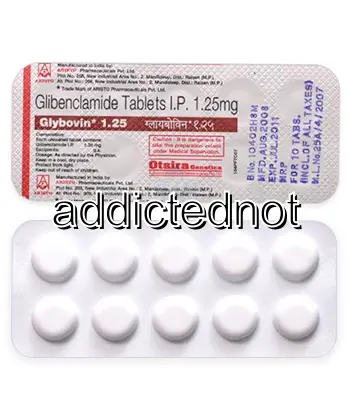| Package | Dosage | Price | Price per Dose | |
|---|---|---|---|---|
| Dosage: 2,5mg | ||||
| 360 pill | 2,5mg | €264.94 | €0.73 | |
| 180 pill | 2,5mg | €142.54 | €0.79 | |
| 120 pill | 2,5mg | €102.22 | €0.85 | |
| 90 pill | 2,5mg | €83.50 | €0.92 | |
| 60 pill | 2,5mg | €60.46 | €1.01 | |
| 30 pill | 2,5mg | €35.98 | €1.20 | |
| Dosage: 5mg | ||||
| 360 pill | 5mg | €233.26 | €0.65 | |
| 180 pill | 5mg | €135.34 | €0.75 | |
| 120 pill | 5mg | €95.02 | €0.79 | |
| 90 pill | 5mg | €74.86 | €0.84 | |
| 60 pill | 5mg | €51.82 | €0.86 | |
| 30 pill | 5mg | €30.22 | €1.01 | |

Glibenclamide Description
Introduction to Glibenclamide
Glibenclamide, also known as glyburide in some regions, is a medication primarily used to manage type 2 diabetes mellitus. It belongs to the class of drugs called sulfonylureas, which work by stimulating the pancreas to produce more insulin. This increased insulin release helps to lower blood glucose levels, making it an effective option for many patients who struggle to control their sugar levels through diet and lifestyle changes alone.
Mechanism of Action
The medication acts on the beta cells of the pancreas. By closing ATP-sensitive potassium channels, glibenclamide causes cell depolarization, which subsequently opens voltage-dependent calcium channels. The influx of calcium triggers the release of insulin stored in the pancreatic beta cells. This mechanism provides a rapid and sustained response to elevated blood glucose, helping to maintain normal levels throughout the day.
Benefits of Glibenclamide
Many users appreciate that glibenclamide is effective in lowering blood sugar levels. It often leads to improved glycemic control, especially in the initial stages of therapy. Patients who respond well to this medication can experience a significant reduction in hyperglycemia, which helps prevent the long-term complications associated with poorly managed diabetes. Additionally, it’s generally affordable and widely available in many countries, making it a popular choice among clinicians and patients.
Possible Side Effects
Despite its effectiveness, glibenclamide can cause side effects in some individuals. The most common include hypoglycemia, which can manifest as dizziness, sweating, shakiness, and hunger. Serious hypoglycemic episodes require immediate attention and may involve loss of consciousness if left untreated. Some users might experience gastrointestinal issues such as nausea or diarrhea. Allergic reactions, although rare, can also occur, presenting as skin rashes or swelling. Long-term use warrants regular monitoring to prevent and manage adverse effects.
Precautions and Contraindications
Glibenclamide should be used cautiously in people with renal or hepatic impairment, as these conditions can increase the risk of hypoglycemia. It's also contraindicated in patients with type 1 diabetes or diabetic ketoacidosis. Pregnant and breastfeeding women should consult their healthcare providers before using this medication. Combining glibenclamide with other drugs that lower blood sugar can increase the risk of hypoglycemia and requires careful medical supervision.
Usage and Dosage
The dosage of glibenclamide varies based on individual patient needs, blood glucose levels, and response to treatment. It is typically taken once or twice daily, with meals to reduce gastrointestinal discomfort. Patients are advised to adhere strictly to the prescribed dose and schedule. Regular monitoring of blood sugar levels is essential to adjust the dosage if necessary and to prevent hypoglycemic episodes.
Conclusion
Glibenclamide remains a valuable option for managing type 2 diabetes, especially for patients who respond well to sulfonylurea therapy. While it offers effective glycemic control, users should be aware of potential side effects and adhere to medical guidance. Proper monitoring and lifestyle modifications can further enhance the benefits of this medication and contribute to better overall health management for individuals with diabetes.